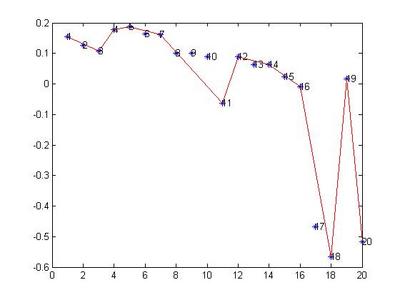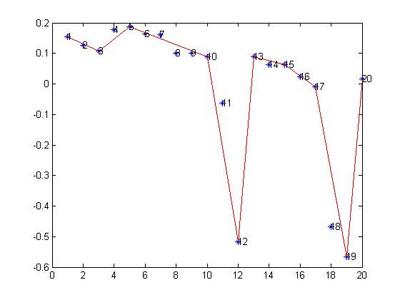The basic idea to produce an interrupted pattern is as the following:
- The first step is to identify some rather long dominated or drifting patterns in the original sequence.
- Add some noises into these patterns.
It's relatively easy to find some dominated or drifting patterns in the seuqnce of entries. We should firstly prepare a suitable dataset which contains some patterns we want.
But for the second step, it seems not so simple. Noise is the important issue that we need consider.
What is the noise? There are at least two choices. One is that we introduce new entry from other irrelevant blogs. The other is just to adjust the original sequence so that some entry suddenly happens where it should not be.
- The introduction of new element in the entries space, will lead to the modification of new space generated by means of MDS. Thus, the original patterns can not be maintained. The result is unexpected.
- Just adjusting the order of the original sequence won't change the existing patterns, and it's safe.
So I believe the second choice is better.
Another issue that needs noting is about the curve segmentation algorithm. When we changes the order of entries in the sequence, patterns might change too for the curve segmentation algorithm. That means, even though we use the second selection to generate the interrupted patterns, it's not safe enough: the original patterns may be changed, so that the interrupted pattern can not happen as expected. See figures below.

The figure above is the original plot describing all of entries in a sequence. The labels of each point are for the sequence number of entries. The segment from No.8 to No.15 is a topic dominated pattern, and we decide to move point No.19 or No.20 into this segment in order to produce the interrupted pattern.

We move point N0.19 into the position between No.10 and No.11 and get the figure above. The adjustation changes the original pattern so much that the dominated segment #8 to #10 doesn't exist any longer. I believe that it's due to the value of #11 is so close to the original segment.

The figure above describes the case when we move point #19 to the place between point #10 and #11. An interrupted pattern is generated in this case. The value of #19 is far different from others in the original topic segment (from #8 to #15 in the first figure).

In the last figure, we move both #19 and #20 to the place between #10 and #11 in the original (first) figure. In result, we get an interrupted pattern too.





